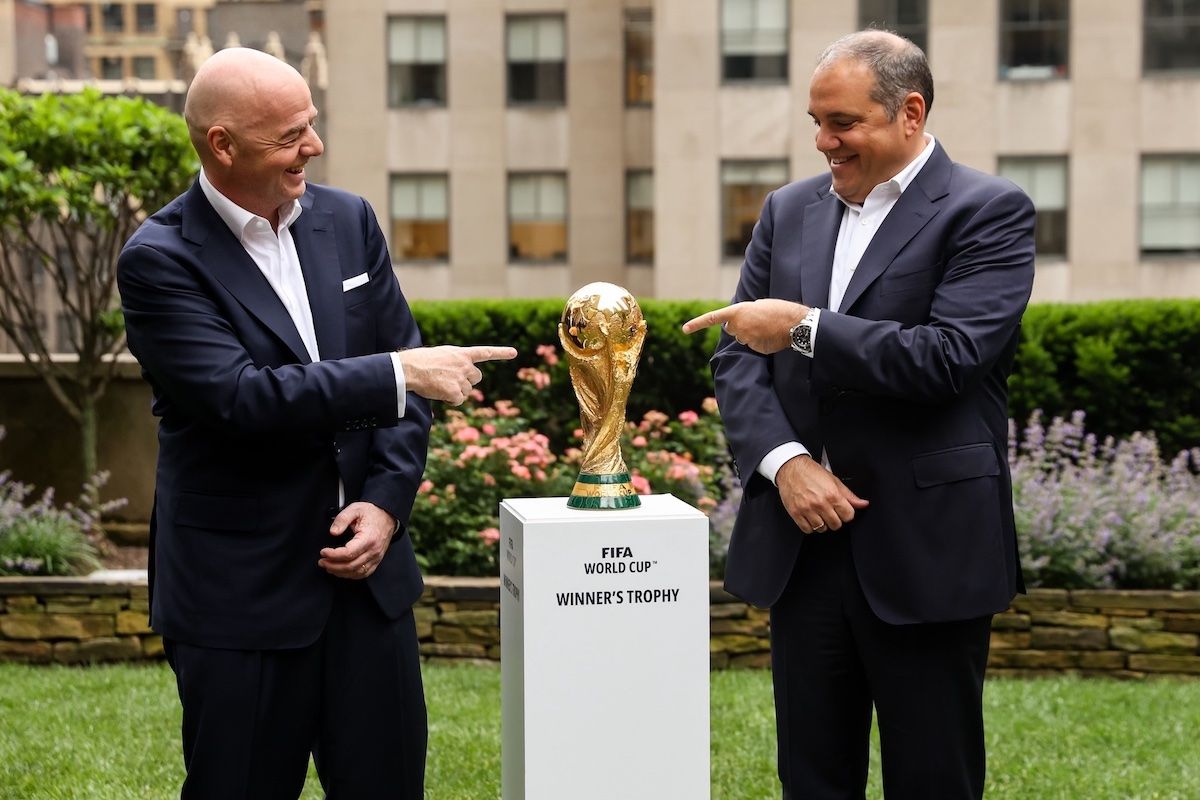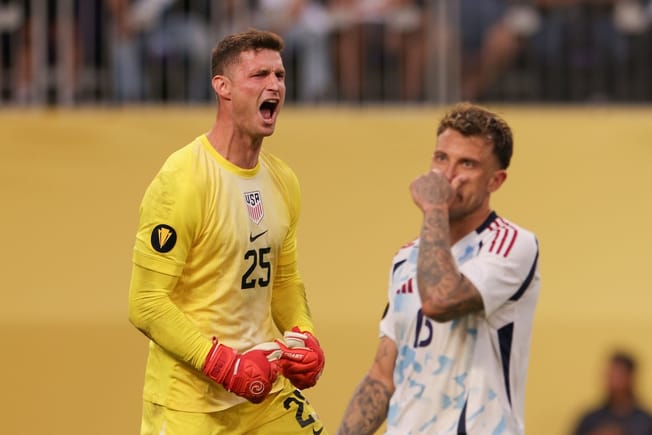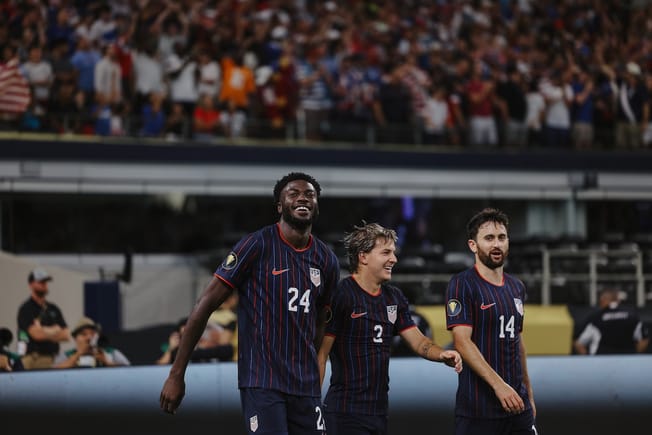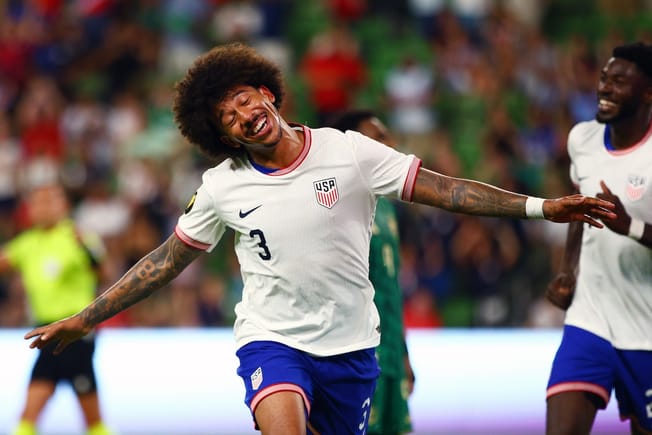Quick Hits
- With the two World Cups in the next nine months, now is a perfect time to step back and examine the state of Concacaf, the United States’ home in the FIFA ecosystem
- How is the federation fairing on the international level? What about on the club level? And are there signs of progress? Let’s talk about that
As someone who covers the region broadly and watches far too many obscure games, I’d say I’m a decent person to take the temperature of Concacaf, the United States’ home in the FIFA ecosystem.
I launched a newsletter to tell stories from the region. It’s my unironic love letter to a confederation often the subject of ridicule or outright derision from the ‘sophisticated soccer countries’ like Mexico and the United States. But when I was asked to write this column about the state of Concacaf, I started wondering: how do we judge an entire region?
Do we want the region’s president Victor Montagliani (pictured above, right) to come out to a buttoned-up room and say, “The state of Concacaf is strong!”? Can we judge it based entirely on the Men’s World Cup, which is certainly the most high-profile test teams in the region will face in the next year? If so, it’s not looking too rosy. Mexico, the United States and Canada all are at various levels of panic after losing one of their two September friendly matches.
Victor Montagliani (CONCACAF, President) and Alexi Lalas discussed the growth of the women's game and international football this morning.#SoccerexAmericas pic.twitter.com/n8xdKto336
— Soccerex (@Soccerex) March 15, 2022
Is it about which confederation will win the next women’s World Cup? Europe is gaining, but with the current world champions and the Olympic gold medalists, Concacaf can claim supremacy there. Should we look and see whose minnows would beat each other? Look, I’d love to see a Bonaire vs. San Marino game at a tournament with Sri Lanka and Eritrea somewhere in the mix. But I’m not sure FIFA will sponsor it, given it, uh, wouldn’t draw the same number of eyeballs as Qatar 2022.
The issue with declaring where Concacaf is with any certainty is the same as basically everything else in the region: it’s complicated.
IT’S COMPLICATED
How could it not be? While every confederation is working to bring together a number of disparate cultures and interests, Concacaf has three wildly different groups. There’s the North American sub-confederation, the Central American one, and then the Caribbean – the group that carries by far the most power numerically in the one nation, one vote setup but has the least political and cultural power in the sport.
Let’s take it in sections and look first at the men’s international game.
There’s a clear ‘upper class’, with Mexico, Canada, Costa Rica and the United States a cut above. It looked like the Ticos would be replaced by Panama, but a late, furious charge in World Cup qualification and the strength of their rising stars put them in this category. The rest are indisputable. After that, there’s a bit of a middle class forming. Canada jumped out of this group to join the top squad.
One of the upper class teams’ biggest frustrations has been a lack of competition within the region. As an example, Mexico doesn’t feel like it gains anything from going to Suriname in the Nations League. The U.S. would rather schedule its own friendly than square off with Grenada. Yet, how are these smaller teams ever going to compete if they don’t get opportunities to knock off the big boys?
FT: USA 5 - 0 Grenada
— USMNT Only (@usmntonly) June 11, 2022
4 goals for Jesus Ferreira. pic.twitter.com/KdIo94LVo5
The Concacaf Nations League may not be what the top squads want, but it’s what the middle and smaller sides need: regular competition against teams near their level.
Teams in the middle class like Guatemala, Curacao, Panama and Haiti are benefitting, but so too are even smaller teams. The Bahamas, Puerto Rico and Aruba are just some nations that have shown big fight in the CNL and hope one day to compete in tournaments like the Gold Cup.
In that sense, things seem to be going in the right direction for the region as a whole when it comes to men’s international teams. Progress will be slow, but the important thing is that there is progress.
LOOKING TOWARDS THE WOMEN’S INTERNATIONAL GAME
Concacaf is in a different position in the women’s international game. Why? Because some of the top teams in the world, namely the United States and Canada, are already in the region.
Yet, things start to look awfully similar to the men’s side when we dig a little deeper. Many smaller nations in Concacaf have neglected or outright ignored the women’s game, either figuring they won’t compete or they’re operating with outdated stigmas about women and girls making a career out of professional sports. Concacaf, once again, is using a model designed to force these teams to care.
Whether it be out of embarrassment because of poor results in official competitions or a desire to qualify for things like the inaugural W Gold Cup, the minnows are being told to swim in the water. Even if they’re swept up in a strong current, at least they’re getting wet.
The top teams continue to forge their own paths as well, with the U.S. and Canada playing prestigious friendly matches and tournaments (OK, this may be charitable to the Arnold Clark Cup). That said, they’re feeling the heat from a group of rapidly improving European teams.
The USWNT has announced that it will play England — and the match sold out faster than any women's soccer match in history.
— Front Office Sports (@FOS) August 3, 2022
The World Champions will meet the European Champions in front of 90,000 fans at Wembley in October 🇺🇸🏴 pic.twitter.com/eefhFYRW7D
While it’s good for the sport to have more competitive balance, North American fans may have a much more nervous summer in 2023 than they’d like.
CONCACAF’S CLUB SCENE
When it comes to the club game, there’s still plenty to be done.
The new format for the Concacaf Champions League is designed to give fans more matchups between Liga MX and MLS, the clear-cut top two leagues in the region. With new sub-tournaments, it also should help raise the level of the leagues in Central America and the Caribbean.
The women’s club game lags at the continental level. A Champions League should be on the way, but plenty of Mexican teams are taking matters into their own hands with friendly games against NWSL teams. Still, Central American leagues shouldn’t be discounted and need a path to play challenging opposition.
It’s not an easy task to take Concacaf’s temperature, and there aren’t quick fixes to mend the many gaps throughout the region.
The current leadership, however, outwardly appear to be more concerned about doing their jobs than illicitly lining their own pockets. That’s no small feat in a region that has been crippled by corruption for decades. If they can continue to innovate and find ways to raise the level of small countries and leagues while demanding more from top performers, Concacaf will go from a punchline to a powerhouse. Or, at least from a straggler on the global level to a region that must be taken seriously.
For now, though, it’s clear this confederation lags behind the competition in Europe and South America.
So what’s the state of Concacaf? It depends who you ask. Progress is being made, but it’s important to continue pushing for evolution so the governing body’s president can confidently stride onto a stage one day and say “The state of the region is strong!”
Or, you know, something like that.







Comments